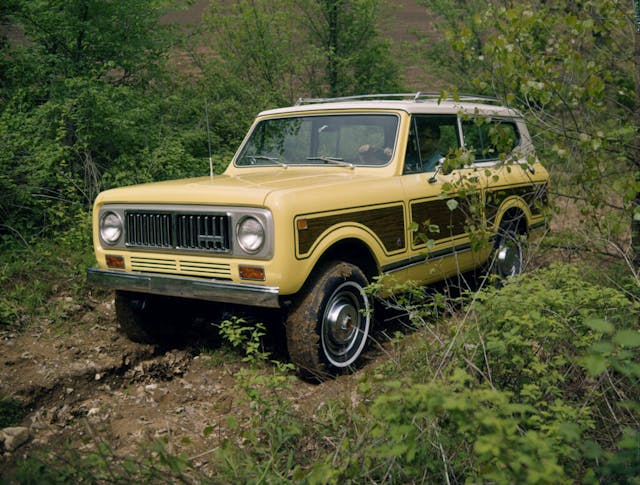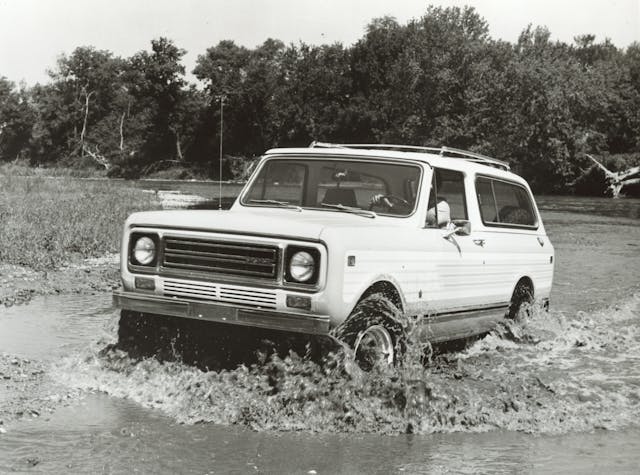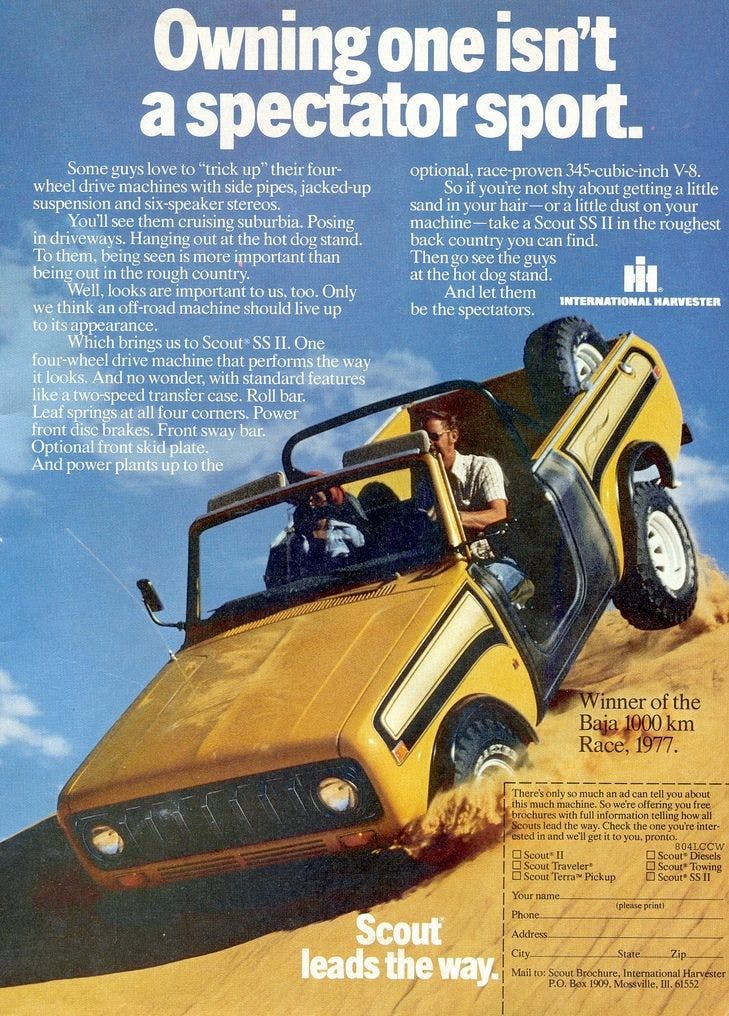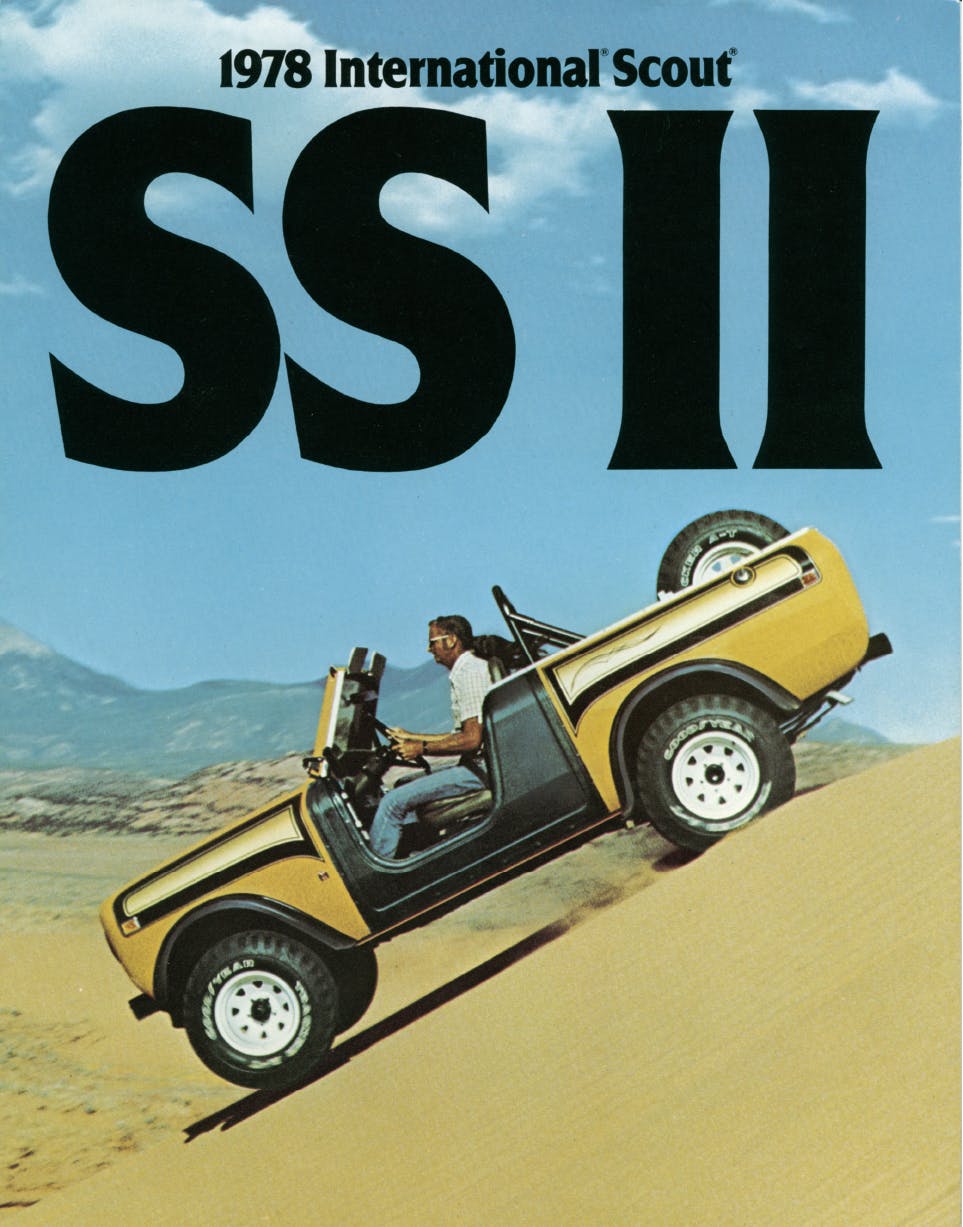Love vintage Broncos? Scout this ’70s alternative
Ted Ornas, chief designer at International Harvester, got a rather open-ended directive from the company’s top brass in 1959. They wanted a go-anywhere vehicle, but they had no clear idea what that would entail. According to Ornas, he was told to “design something to replace the horse,” so he went to work on what would eventually become the Scout 80. Debuting as a 1961 model, the Scout was an affordable, rough-and-tumble utility vehicle with available four-wheel drive, sort of like an Army jeep but with more creature comforts. Almost immediately, International had a hit on its hands.
Fast forward to the end of the 1960s, and thanks primarily to Jeeps and Scouts, the 4×4 had become a small but popular segment. Ford’s Bronco (from 1966) and Chevy’s Blazer (from 1969) were now on the scene, as were small numbers of Toyota Land Cruisers and Series Land Rovers. International Harvester was feeling the pressure, and though IH had steadily updated the Scout through the decade, it was time for a significant evolution of the little truck. Enter the Scout II—a tempting Bronco alternative that appreciated steadily during the recent market boom and is currently riding steady.

Sitting on the same 100-inch wheelbase as its predecessors, the Scout II was now 10 inches longer (mostly behind the rear wheels) and 1.5 inches wider. The truck’s dash had a more car-like appearance, and more amenity-rich packages became available in an effort to provide a more civilized experience. That said, it was still an incredibly capable off-roader, a differentiation that IH’s ads never failed to mention.
Configurability was one of this segment’s calling cards, embodied by the Scout’s three different setups: roadsters (essentially pickups with a short removable hardtop), soft tops, and Traveltops (later dubbed Scout Wagons) with removable but large and heavy steel hardtops. The Scout Terra and Traveler, produced from 1976 to ’80, had an 18-inch longer wheelbase and benefitted from lighter fiberglass tops.
And that was just the body styles. A wealth of drivetrain options further gave Scout buyers the ability to tailor the truck to their individual needs. Initial engine offerings included the base 196-cubic-inch four, a 232-cubic-inch straight-six, and a 304-cubic-inch V-8, all of which were updated versions from the Scout 800. A more powerful 258-cubic inch six-cylinder arrived shortly after the truck’s debut, and a 345-cubic-inch V-8 filled out the early range of powerplants, though IH would offer naturally aspirated and turbocharged diesel straight-sixes from Nissan toward the end of the Scout’s life. A variety of three- and four-speed manuals were available, along with a three-speed automatic.
Power was sent to the wheels via a Dana 30 front axle and a Dana 44 rear through 1974, after which the Dana 44 was standard at both ends. That same year, power assist and front disc brakes became standard.
While a number of trim packages were available from the factory, the 1977–79 SSII, or Super Scout II was perhaps the most well known and today is the most desirable. A stripped-down soft-top model, the SSII gained fame for its off-road racing prowess, though the four different sub-trims of production models went from mild (the Rancher Special) to wild (the Baja Cruiser). All SSIIs featured open door sections with plastic inserts and soft doors available in black or white. Inside, the bucket seats were fixed rather than recline-able, and the rear seat was optional. A snap-on defroster cover came standard to help keep dust out of the vents. Underneath, a set of three spring leaves with one overload leaf helped beef up the suspension, and skid plates protected the transmission and fuel tank. The SSII sported its own unique grille, as well.
About 260,000 Scout IIs were built between 1971 and 1980, and given the various powertrains and options, you can find one to fit almost any budget. Rust and hard living have taken many a Scout off the trail, though, so there aren’t as many available as the raw production numbers might suggest. The roughly 4000 SSIIs built are the most valuable, with a median condition #2 value of $64,750. The overall median #2 value for 1972–80 Scout IIs, however, is $42,200 and the #2 value for certain configurations dips well below 30 grand.
The Scout’s recent ascendancy trailed the sharp rise of the original and second-gen Broncos, both of which led the charge in this segment’s growing popularity. Prior to the recent boom that started in 2020, the Scout trundled along, about as valuable as a similar-quality contemporary Chevy Blazer and about 10 grand cheaper than a Toyota FJ55. All of these vehicles had been gaining value and popularity at a steady if not brisk pace. Since 2022, though, the vehicles in this segment that experienced the strongest growth (like the Broncos) have also retreated the most, and the trucks with more measured growth (like the Scout) merely leveled off or posted small losses. These all appear to be moves of a popular segment in a cooling market.
The general stability in the Scout’s pricing, and in this segment as a whole, is partly down to demographics. Gen-X loves early SUVs and legitimized the segment as collector-worthy almost as soon as it began buying collector vehicles. The Scout’s numbers bear this out: though Gen X currently makes up 31 percent of the market as a whole, the generation represents more than 46 percent of Scout buyers. Millennials similarly display enthusiasm for Scouts, making up over a quarter of quotes sought though they hold a 22 percent market share overall. It’s this kind of generational interest that was a strong factor in causing us to pick the Scout II for our Bull Market List in 2020.
In the end, Ornas’ “something to replace the horse” has proven to be a popular and trusty steed, if not quite the show pony that Ford created. It’s also one whose appeal has enjoyed surprising longevity, especially when you remember that the Scout and other IH consumer products disappeared decades ago. That said, VW is currently reviving the Scout nameplate for a series of electric SUVs, which may revive interest in the original.
It may be harder to find parts for Scout IIs than it would be for something from the Big Three, and a fair amount of fiberglass has taken over for metal bodywork over the years. Fortunately, though, they also have an incredibly dedicated following with resources aplenty to help keep these rigs on the path, and they’ll always stand out in a crowd of Broncos and Blazers. All things considered, it looks like the Scout II market will remain healthy for generations to come.

***
Check out the Hagerty Media homepage so you don’t miss a single story, or better yet, bookmark it. To get our best stories delivered right to your inbox, subscribe to our newsletters.





Cool trucks but unlike early Bronco’s few repo parts are made and these rusted even in AZ.
You’re not looking in the right places for repo parts
Great article. I guess I fit the demographic as a Gen Xer who bought in 2016. Definitely enjoy watching the value curve, but it’s just too cool to sell.
Co-worker bought a ‘78 SSII new. Think it started rusting out a month later.
Always liked them, but they didn’t last long here in the rust belt. By the 3-4 year old mark, they were pretty well shot body wise.
I grew up enamored with Scouts: my grandfather ran the public works for an Upstate NY town and so was subscribed to ‘International Trails’ magazine, published by the manufacturer. It was mostly about big trucks and tractors, but there’d always be an article about, say, a geologist living and working out of his Scout in the Nevada desert. And I really dug that Hoffmeister-style kink in the rear side windows.
I had some great adventures, too, in Scout 80s and 800s, including a friend’s father driving our whole (small) Scout troop through the swampland on his property.
I’ve test-driven a few Scout IIs over the years, but each was disappointing in one way or another. I got my International fix instead by owning a Travelall for several years.
Had a ’74 with the 345 V8, Nothing stopped this vehicle except the occasional gas station.
Scout, dial 1-800 find a part. Late model factory bus schedule with light up thumb included.
Good luck finding one in good condition. They rusted as badly as the Bronco and have little aftermarket parts support.
There are quite a few dedicated Scout parts suppliers. The engines are industructable and most of the other mechanical parts are off the shelf stuff. Most body parts are reproduced..
“Love vintage Broncos? Scout this ’70s alternative.”
Spoken by someone with no first hand knowledge.
You might as well say “Love vintage Mustangs? Check out this Camaro alternative”
At Christmas 2014 I brought home a 1980 with a 304/auto, mild 2 1/2″ lift, 33s on American Racing Outlaws, and a relatively new hunter green paint job for just $5,500. The interior was basic with only loose mats so I could easily see where the floor pans had been repaired, but it did have a pair of cool, if somewhat wobbly, plaid swivel seats out of a Midas version. It was the bomb – my two young boys thought it was the greatest family present ever. They loved it as it upstaged every lifted green golf cart at the neighborhood pool the next summer. I never intended to make it perfect; I was just going to cover the floors with Line-X, tighten up the seats, solve the wandering steering issue and use it as fun summer runabout and winter hunting vehicle until something else caught my eye. Though I kept it garaged, after less than a year what looked like a minor paint bubble in the windshield frame when I bought it had become a hole I could stick my thumb through. And there were some signs of other rust areas returning. I enjoy wrenching as there’s typically an end in sight with a particular problem solved. Rust repair not so much…you may never see the light at the end of the tunnel. I ended up selling it for $7,500 before the next Christmas. My guess it would go for $15 or $20k now in the same condition.
Ford had the more realistic name though. They rode like you were on a bucking bronco.
A fun truck but an owner I know said parts are not easy to come by.
The x father in law had one with the big V8. Got about 12 mpg imperial. A solid heavy vehicle that could tow just about anything. It ended up getting a fibreglas tailgate due to severe rust back there but otherwise seemed dependable.
I’m on my 4th. From my first scout bought for $300 in 1987 that was more rust than metal but it’s bulletproof IHC 304 drove from NYC to Florida and back no problem. Junked it when the oil pressure barely got above the low mark. Learning years later they are notorious for having loose tarnished nuts on the back of the oil pressure gauge that would result in a false low reading.
Second one was T boned by a drunk who ran a red light. Third one I bought sight unseen with 107k miles. Sold it 10 years later for the same price with 325k miles to buy a new 2006 Magnum RT because the pregnant wife said “ we needed a reliable family car “
Was never as fun to drive or as easy to fix or reliable as the scout so I sold it for my fourth that is still our daily driver today that those twins a few years ago learned to drive on..
Parts are out there. Several suppliers in Iowa and more on the west coast and eBay everywhere else. Panels rust from the inside out. So once you see bubbles it’s too late. Rust converters and rust sealers will be common in your garage.
If it’s the IHC 4 or 8 cylinder you will almost never need to rebuild it unless you decide to run it above its suggested 4,000 rpm redline. Yea it’s not a race car but I can drag a house off it’s foundation. The 6 cyl was a good AMC motor but still not an actual truck engine and that Nissan diesel…
There was a turbo IHC 4 and a propane option. PTO and overdrive.
My family are like neighborhood celebrities because of this truck. Questions , thumbs up and smiles where ever we go. I’ll never want to own anything else.
Editor’s Note: Having just read the rear-end design pining elsewhere here, and seeing the huge decal-sided Scouts, it dawned on me somebody ought to research and produce a piece on DECALS Usage.
I’ll never forget telling my second-generationi Chrysler-Plymouth dealer Dad that I was considering a Porsche 944. He paused and said: “Do they come with a chicken decal on the hood?” He closed the conversation (and my consideration) with a dismissive: “Not much of a gentleman’s car…”
Fast-forward to 2018 when I bought my first Porsche (Panamera S), a sharp, long-time friend to whom I had relayed that original conversation years earlier, without blinking said: “Your dad would approve, this is much more of a ‘gentleman’s car.'”
Had a 73, wish I had never sold it. Only real rust problem I had was the top. 345, automatic (used a torqeflite) was a little bit thirsty but man it could pull anything. Remember most people weren’t to fond of IH but they built a tough truck